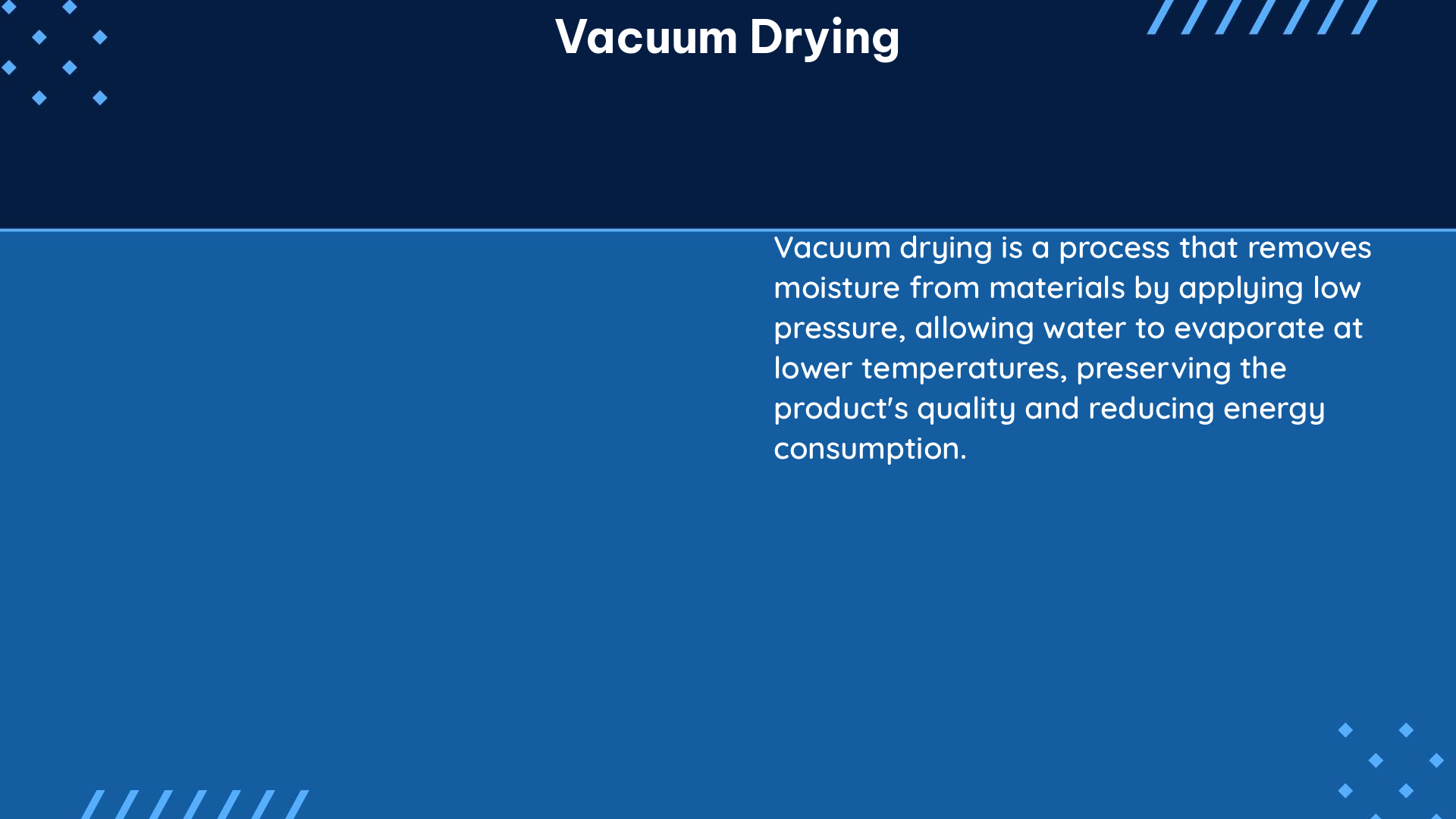Vacuum drying is a highly efficient and precise method for removing moisture from a wide range of materials, including food, pharmaceuticals, and industrial products. This process involves drying the material under reduced pressure, typically at lower temperatures than conventional drying methods. The benefits of vacuum drying include better retention of quality attributes, improved efficiency, and the ability to dry small samples with precision.
Understanding the Fundamentals of Vacuum Drying
Vacuum drying works by reducing the pressure around the material being dried, which lowers the boiling point of water. This allows the material to be dried at lower temperatures, often between 40-80°C, which can help preserve the quality and integrity of the product. The reduced pressure also enhances the rate of moisture removal, as the water vapor can be more easily extracted from the material.
The mass transfer coefficient, k, used in the vacuum drying model is determined using the Sherwood number, Sh, which is calculated from dimensionless equations reported in the literature. The diffusion coefficients of water vapor at 60 and 80°C are 3.09 × 10^-5 and 3.43 × 10^-5 m^2/s, respectively.
Advantages of Vacuum Drying

-
Retention of Quality Attributes: Vacuum drying can help preserve the quality attributes of the dried material, such as color, flavor, and nutritional value, compared to conventional drying methods. For example, a study on chicory root cubes found that samples dried using a vacuum drier at 60°C and 25 mmHg had better rehydration, lower shrinkage, and higher retention of quality attributes compared to those dried using hot air.
-
Improved Efficiency: Vacuum drying can be significantly faster than conventional drying methods, such as oven drying or air drying. For instance, vacuum-drying of lumber from 67 to 7 percent moisture content (MC) required only 88 hours, which is only one-seventeenth the time required by conventional kiln-drying.
-
Precision Drying of Small Samples: Vacuum drying is particularly useful for drying small samples with high precision. A study comparing the speed-vacuum method and heat-drying method for measuring brain water content found that vacuum-drying allowed the precise quantification of small samples down to 30–45 mg with a drying length of 48 hours, while the oven technique took 24 hours.
Mathematical Modeling of Vacuum Drying
Researchers have explored various mathematical models to describe the vacuum drying process and improve its efficiency. Some of the commonly used models include:
-
Midilli and Kucuk Model: This model has been found to yield the largest
R^2_adj, the smallestχ^2, and the smallest RMSE in vacuum oven drying experiments, indicating its best fitting effect. -
Page Model: This model has also been used to fit the drying curves for electric oven drying.
-
Two-term Model: This model has also been applied to electric oven drying experiments.
The use of these mathematical models can help optimize the vacuum drying process, improve the accuracy of drying predictions, and enhance the overall efficiency of the drying operation.
Applications of Vacuum Drying
Vacuum drying has a wide range of applications, including:
-
Food Processing: Vacuum drying is used to dry a variety of food products, such as fruits, vegetables, and herbs, while preserving their quality attributes.
-
Pharmaceutical Industry: Vacuum drying is used to dry pharmaceutical ingredients and formulations, ensuring the stability and quality of the final products.
-
Industrial Drying: Vacuum drying is used in various industrial applications, such as the drying of lumber, ceramics, and other materials, where it can provide faster drying times and better product quality.
-
Research and Development: Vacuum drying is a valuable tool in research and development, particularly for drying small samples with high precision, as demonstrated in the brain water content study.
Conclusion
Vacuum drying is a highly efficient and precise method for removing moisture from a wide range of materials. Its ability to preserve quality attributes, improve drying efficiency, and enable the precise drying of small samples make it a valuable tool in various industries and research applications. By understanding the fundamentals of vacuum drying and the use of mathematical models, practitioners can optimize the drying process and achieve superior results.
References
- Comparison of Hot Air and Vacuum Drying on the Retention of Quality Attributes of Chicory Root Cubes
- Comparison of Speed-Vacuum and Heat-Drying Methods for Measuring Brain Water Content
- Vacuum Drying of Lumber
- Evaluation of Drying Kinetics and Quality Attributes of Vacuum-Dried Pumpkin Slices
- Modeling and Optimization of Vacuum Drying of Pumpkin Slices Using Response Surface Methodology

The lambdageeks.com Core SME Team is a group of experienced subject matter experts from diverse scientific and technical fields including Physics, Chemistry, Technology,Electronics & Electrical Engineering, Automotive, Mechanical Engineering. Our team collaborates to create high-quality, well-researched articles on a wide range of science and technology topics for the lambdageeks.com website.
All Our Senior SME are having more than 7 Years of experience in the respective fields . They are either Working Industry Professionals or assocaited With different Universities. Refer Our Authors Page to get to know About our Core SMEs.